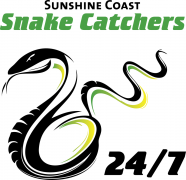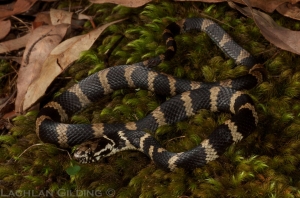Significance to Humans:
Bites from this species have caused one human fatality and symptoms include severe local pain, swelling, headaches and nausea. Bites from this species should be treated immediately and attended to with correct first aid.
General description:
Head relatively broad & distinct from neck. Body usually banded with pale grey/ yellowish bands across rusty brown or black, strongly marked in mid-body area & weaker contrast at head & tail. Darker face & head has distinctive pale brown, cream or white blotches or bars on either side & lips. Belly cream to grey, often with dark edging. Unbanded specimens also recorded. Midbody scales at 21 rows.
Average Length:
90cm with a maximum length around 1.2 metres.
Habitat in SE Qld:
Rainforest, wet sclerophyll forest, vine scrub and rocky outcrops in wet forest.
General habits:
Good climber, mostly arboreal. Shelters in tree hollows, under loose bark and ground cover such as rock exfoliates. Nocturnal.
Diet:
Small mammals, lizards and frogs.
Local distribution:
Prefers wetter forested suburbs including but not limited to the Sunshine Coast hinterland and suburbs surrounding Conondale National Park. Does not occur in suburban areas of the Sunshine Coast.
Around the home:
The habitat specific requirements of the Stephen’s Banded Snake sees this species found in and around homes only in areas of suitable habitat at Mt Nebo and Mt Glorious within the Brisbane region. A local snake catcher has confirmed numerous calls involving the species entering homes.

